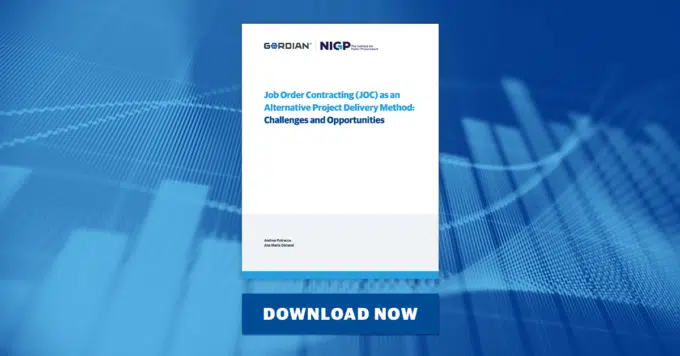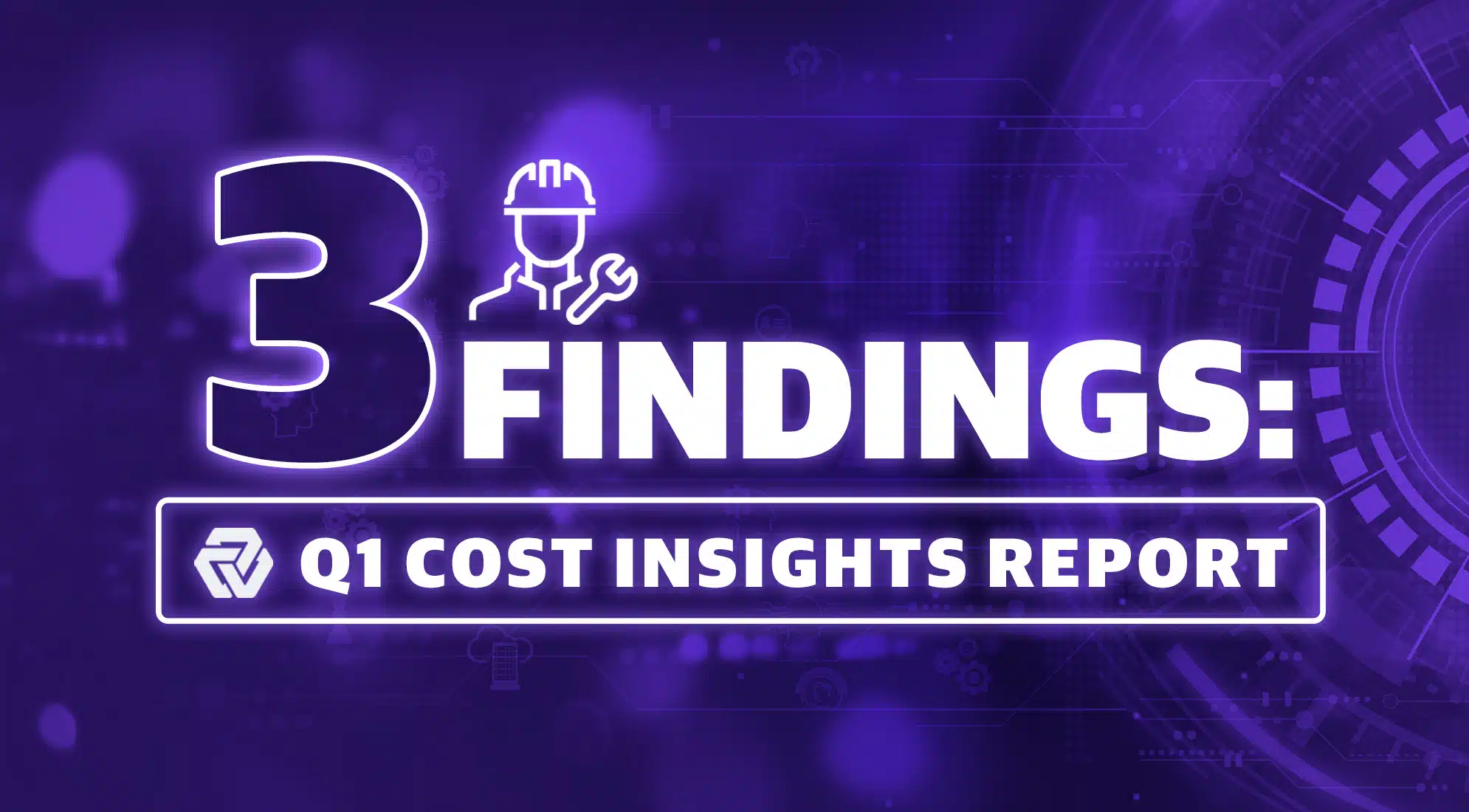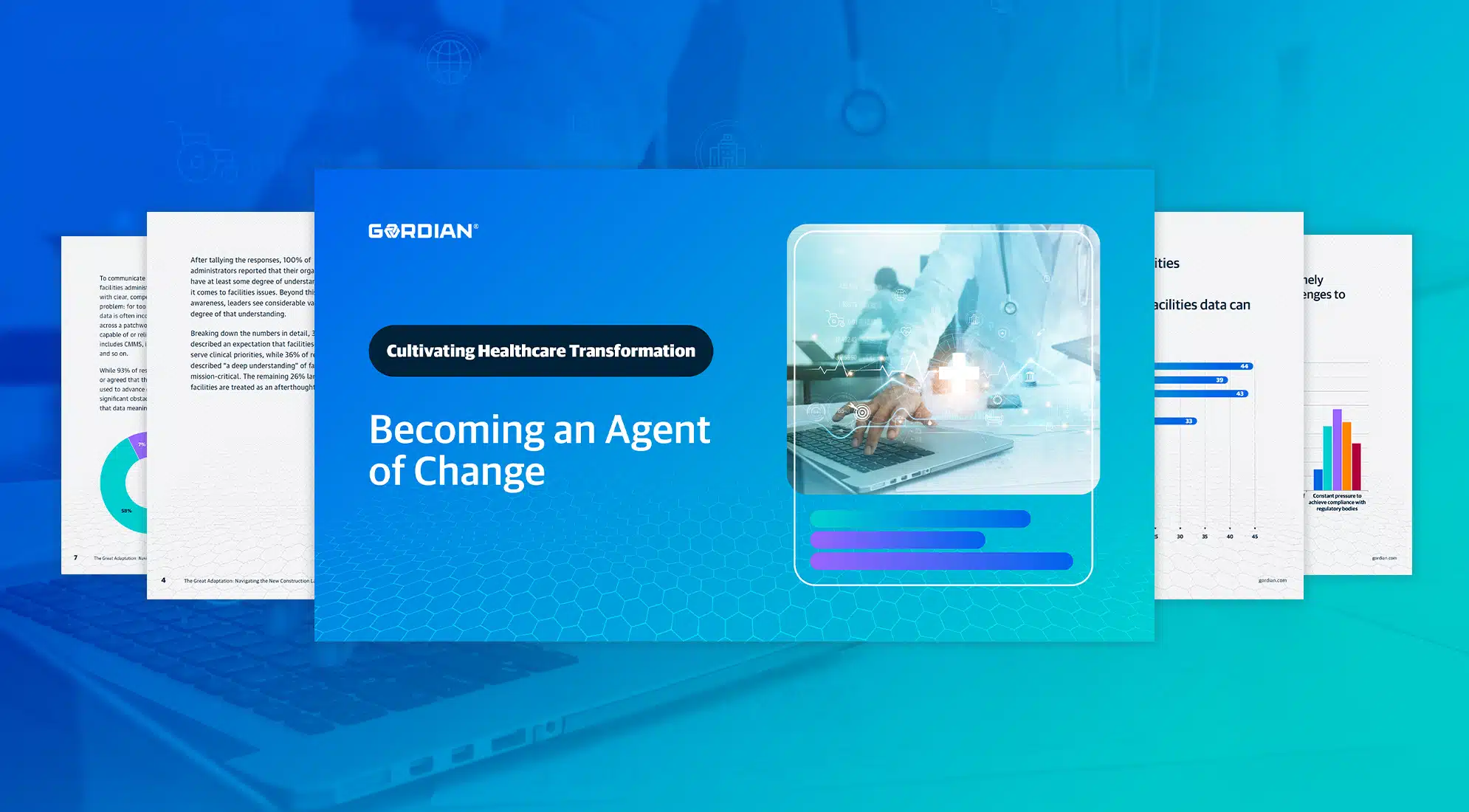In the ever-evolving landscape of public sector construction, a myriad of challenges confront leaders tasked with overseeing critical infrastructure projects.
This article identifies four of those key challenges: cost escalation, capacity gaps in facilities leadership, delivery challenges in construction programs, and advancing corporate sustainability. Each issue is thoroughly examined, offering a profound understanding of their implications and practical solutions. From leveraging benchmark data insights to navigating cost uncertainty to embracing innovative procurement processes, explore actionable steps that public sector organizations can leverage to enhance efficiency, effectiveness, and sustainability in their construction projects.
1. Cost Escalation
The ramifications of escalating construction costs reverberate through public sector organizations, manifesting in three distinct consequences:
Diminished Purchasing Power: Fluctuating costs erode the ability of public sector entities to meet immediate and future needs, hindering safety measures and asset preservation. The revenue generation plans upon which public budgets rely are often undermined by unexpected increases in construction inputs. Such deviations from initial cost estimations can severely limit the purchasing power of public sector organizations, curtailing their ability to respond effectively to the pressing needs of maintaining facilities, ensuring safety, and undertaking preventive maintenance measures.
Erosion of Trust: Inaccurate cost estimations can lead to public distrust, challenging the perception of wise fiscal management and responsible use of taxpayer funds. Taxpayers, facing their own cost of living pressures, expect transparency and prudence in the allocation of public funds. When projected project costs do not align with market realities, public trust in the judicious use of funds is jeopardized. This disconnect between expected costs and actual market prices can erode confidence in public sector entities, necessitating a reevaluation of cost estimation processes to restore trust and accountability.
Contractor Frustration: Pre-construction stress looms large as projects face cancellation or delays due to cost discrepancies, leading to frustration within the contractor community. Contractors, faced with uncertain project outcomes and fluctuating costs, experience significant frustration and anxiety. The frequent cancellation or deferral of projects exacerbates this frustration, creating an atmosphere of uncertainty and instability within the contractor community. To address this issue, public sector entities must adopt more robust cost estimation methods and streamline procurement processes to provide contractors with greater clarity and confidence in project outcomes.
Solution:
Navigating Change with Benchmark Data Insights
Gordian offers a beacon of clarity amidst cost uncertainty, equipping public sector leaders with industry-leading cost data to inform estimations, plan effectively, and build with confidence. By leveraging benchmark data insights, public sector organizations can navigate cost escalation challenges more effectively, ensuring prudent fiscal management and optimal allocation of resources.
2: Capacity Gaps in Facilities Leadership
Public sector leaders grapple with capacity gaps in facilities teams, exacerbated by retirements, resignations, and remote work dynamics. This scarcity of expertise poses challenges to mandate delivery and infrastructure investments, necessitating innovative solutions to bridge capacity shortfalls.
Departures of key senior leaders as specialist practitioners with knowledge and experience in the dual fields of public procurement and construction or capital planning and asset management are having a noticeable impact. There are a variety of causes attributed to these gaps, including the long-anticipated silver tsunami of baby boomers exiting the workforce as they reach retirement, the “great resignation” phenomenon of more recent times as employees adjust life priorities, and increased talent mobility from the ability to work remotely. The effects may be postponed in many cases as high performers were able to compensate for gaps pending recruitment. As these temporary periods continue, this effort is proving to be sustainable, with greater levels of burnout and turnover in this cadre.
Solutions:
- Innovative Solutions in Construction Procurement
Embracing innovative procurement processes like Job Order Contracting streamlines project delivery, optimizes resources, and mitigates capacity constraints, fostering sustainable practices and bolstering operational efficiency. By adopting Job Order Contracting, public sector organizations can expedite project timelines, reduce administrative burdens, and ensure cost-effective project delivery, thereby maximizing the impact of limited resources and enhancing overall project outcomes. - Empowering Asset Investment Planning
Gordian empowers public sector organizations to streamline investment planning through intuitive technology, leveraging data insights to prioritize projects, optimize budgets, and bridge capacity gaps. By utilizing Gordian’s comprehensive expertise and advanced technological solutions, public sector entities can develop more strategic and efficient asset investment plans, ensuring the long-term sustainability and resilience of critical infrastructure assets.
3: Delivery Challenges in Construction Programs
Public sector leaders face hurdles in delivering funded construction programs, leading to unspent budgets, unmet maintenance requirements, and unnecessary risks. Traditional procurement workflows often exacerbate these challenges, necessitating a paradigm shift towards more efficient and innovative project delivery methods.
Efficiency Through Innovative Procurement
Job Order Contracting emerges as a transformative solution, enabling efficient project delivery, reducing administrative costs, and accelerating program velocity. By implementing Job Order Contracting programs, public sector organizations can streamline project delivery processes, minimize delays, and maximize the impact of allocated resources, ultimately enhancing the overall efficiency and effectiveness of construction programs.
Building Sustainable Communities
Gordian facilitates corporate sustainability objectives by integrating environmental, social, and economic considerations into facility management practices, fostering inclusive spaces and advancing strategic procurement goals. Through strategic procurement practices and innovative solutions, public sector organizations can promote environmental sustainability, social equity, and economic prosperity, thereby contributing to the creation of more resilient and sustainable communities.
4: Advancing Corporate Sustainability
As public sector construction continues to evolve, the imperative of corporate social responsibility (CSR) looms large, demanding attention from leaders and stakeholders alike. Corporate sustainability in this sense will be used to emphasize the organization’s operation in a manner that considers the triple bottom line of environmental, social, and economic impacts, thereby ensuring long-term viability and responsibility to society. Given the budgets and physical permanence of public real property, there is a tremendous opportunity for facilities leaders to contribute to corporate sustainability.
By prioritizing sustainability considerations in procurement processes and facility management practices, public sector organizations can lead by example and drive positive social, environmental, and economic outcomes.
Environmental considerations
Let us bind the definition of environmental considerations as including climate change action, energy conservation, and protecting the natural environment from building operations. Globally, the built environment is responsible for nearly 40 per cent of energy-related emissions and half of all extracted materials . Many organizations use management systems such as the International Standards Organization (ISO) framework or industry standards for construction such as Leadership in Energy and Environmental Design (LEED) or Building Owners and Managers Association Building Environmental Standards (BOMA BEST) to guide their work. All of these standards can be used to benchmark performance against policy objectives.
Ideally, environmental and energy efforts can be leveraged into related management activities. For instance, Gordian undertakes facility condition assessments while simultaneously to energy audits. This information can then be used to prioritize recapitalization projects that reduces energy consumption, lowers operating costs, and improves the occupant experience.
One leading best practice is to schedule energy reduction efforts during system life cycle replacement projects identified in a digital capital planning system. Rather than removing an operable oil burning furnace prematurely, Gordian’s planning system empowers teams to budget can be set aside for a high efficiency heat pump at the scheduled replacement date, therefore reducing operating costs, lowering carbon emissions, and ensuring occupant comfort. Another example in play currently is to use Gordian’s Job Order Contracting approach to quickly and cost efficiently replace existing lighting to more efficient fixtures.
Social considerations
In facilities departments, there’s a risk of focusing solely on maintaining the physical aspects of buildings and overlooking that these spaces are ultimately meant to serve the needs of the people using them. The building is only performing well if the people around it are performing well. In the context of public buildings, they can be used to signal the communities values to the world. For example, in Canada we’ve seen indigenous cultural elements and historical tributes woven into designs for buildings as diverse as schools to correctional centers, instilling pride and responsibility to honour original traditions. Equally, in recent times we’ve seen public opposition to physical monuments and place names connected to events or people no longer aligned to contemporary values of society. Facility leaders have a role to play in advancing social sustainability.
A demonstration of this value is ensuring that the built environment functions in a way that includes and is accessible to everyone. “Barriers limit the things people with disabilities can do, the places they can go, or the attitudes of others toward them” . Expectations of a just society are that public buildings don’t introduce barriers to access to public services. These barriers are obvious and infuriating to those live with a disability or care for someone with disabilities . As an employer, not only does a diverse workforce make a stronger team, it’s in the public’s interest to have a diverse and inclusive workforce composition that is reflective of the population it serves.
The Rick Hansen Foundation has developed a facility accessibility rating system that is used for leading commercial owners as well as public owners. The rating serves as a benchmark and points the way to interventions and improvement projects. Gordian has partnered with the Rick Hansen Foundation to incorporate accessibility certifications into facility assessment workflows. The impact of this partnership is that accessibility upgrades become integrated and aligned with the renewal program.
For instance, rather than replacing dark end-of-life flooring with more of the same, facilities teams can introduce a slight modification that includes features like intuitive colours and wayfinding for the visually or cognitively impaired will make a world of difference for their occupant experience. Another example is when the time comes to replace those worn and draughty doors, installing touchless door sensors eliminates the manual operation, thereby helping those with less manual strength and dexterity as well as for those in wheelchairs or walkers. During the pandemic, many also appreciated touchless sensors as a way of preventing the spread of germs. When buildings are made for the needs of all abilities, it makes the buildings better for everyone.
Economic considerations
Government executives are often heard to speak of policy levers available to government to advance strategic priorities. Given the proportionately large budgets allocated to build and maintain public works, facility leaders are well-positioned to contribute to organizational goals through strategic procurement. Specifically, what additional benefits can be realized beyond just the service or product that is being purchased?
One example of an obstacle faced by many public organizations presently is how to stimulate economic opportunities with equity-deserving communities. The arms-length from government Business Development Bank of Canada has a mission to support small and medium enterprises, including communities needing a hand up like minority-owned businesses, woman-owned enterprises, and indigenous business. However, many equity-deserving communities are unable to successfully access public construction work due to onerous and repetitive traditional procurement processes. Small firms with capable construction teams don’t always have the capacity to repeatedly prepare extensive bids that may or may not result in business, especially for routine projects.
An approach that has been successful is Job Order Contracting, an innovative process that is supported by data insights and technology. Job Order Contracting (JOC) is a means of using one compliant, competitive contract to deliver a program of projects, especially renewal, repair, and minor alteration projects. Smaller firms such as emerging equity-seeking contractors, are able to go through the comprehensive selection process once, and either move on to other opportunities if unsuccessful or participate in a program on ongoing job orders. In the United States, JOC programs helped deliver $3.2B annually for public organizations. Of the contractors in JOC program, 35% were from equity-deserving groups. Through the consideration and application of innovative processes supported by strong data insights and technology, many governments and public entities were able to advance economic strategic priorities.
To know more about JOC and how it can help leaders, watch a 3-minute video by clicking HERE.
Promoting Environmental, Social, and Economic Sustainability
By integrating sustainability considerations into procurement practices, public sector organizations can stimulate economic opportunities, promote inclusivity, and lead by example in environmental stewardship. Through strategic procurement practices and innovative solutions, public sector organizations can advance corporate sustainability objectives, driving positive social, environmental, and economic outcomes while creating more resilient and sustainable communities.
Empowering Better Communities Through Innovation
Gordian stands at the forefront of innovation, empowering public sector owners to navigate challenges, optimize resources, and build resilient communities using industry-leading accurate insights, robust technology, and comprehensive expertise. By partnering with Gordian, public sector organizations can unlock new opportunities for efficiency, effectiveness, and sustainability, thereby creating better communities for generations to come.
In a landscape marked by uncertainty, Gordian offers a steadfast partner in navigating complexities, unlocking efficiencies, and building better, more sustainable communities for generations to come. Through innovative solutions and strategic partnerships, Gordian empowers public sector organizations to achieve their goals and drive positive change in the communities they serve.
Conclusion
Proactive measures are essential for overcoming obstacles and driving positive change in public sector construction. By implementing the insights and solutions discussed in this article, organizations can enhance efficiency, effectiveness, and sustainability in their construction projects, ultimately fostering more resilient communities. However, we recognize that every organization faces unique circumstances and may require tailored support to address specific challenges. Therefore, we invite you to reach out to us with your comments, questions, and inquiries. Whether you seek further clarification on a topic discussed here or require personalized assistance, our team is here to support you on your journey towards success in the public construction sector. Contact us today to start a conversation and unlock new opportunities for your organization’s growth and development.






